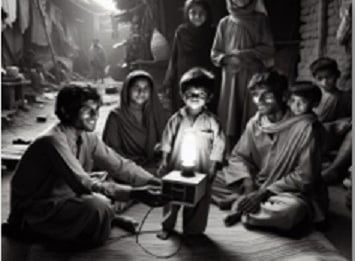IMF Policies Impacting Pakistan's Rural Economy
Explore how IMF policies serve as a double-edged sword for Pakistan's rural economy. While aiming for economic stability, rising fuel and energy costs threaten agricultural productivity, increase rural poverty, and deepen energy insecurity, making it difficult for rural communities to sustain.
POLICY BRIEFS
Sara Iqbal and Muhammad Umar Farrukh
10/30/2024


The rural economy in Pakistan, home to over 60% of the population, faces a complex challenge. Struggling with persistent poverty, agricultural dependency, and limited access to essential services, rural Pakistan is also heavily impacted by the International Monetary Fund's (IMF) economic reform policies. These reforms, intended to stabilize the economy through fiscal discipline and structural adjustments, have significant implications for rural communities, where energy poverty is widespread. As Pakistan tries to meet its financial commitments to the IMF, the question remains: can the government balance these economic demands without further endangering rural livelihoods?


IMF Programs and Rural Economic Realities
Since the 1980s, Pakistan has participated in numerous IMF programs, each accompanied by structural adjustment policies that call for fiscal austerity, reduced subsidies, and an increased tax base. The latest of these, the 2023 $3 billion Stand-By Arrangement (SBA), aims to stabilize Pakistan’s economy, enhance fiscal discipline, and create room for necessary social spending. Yet, in Pakistan’s rural heartland, where access to even basic services remains limited, these policies can feel disconnected from the realities on the ground.
Rural areas are particularly sensitive to cuts in subsidies and price hikes. Farmers rely heavily on affordable fuel and electricity to power irrigation pumps, agricultural machinery, and other essential equipment. When the IMF calls for the removal of fuel subsidies or the increase in electricity tariffs, the impact on the rural economy is profound. The price of diesel, for instance, directly affects the cost of running farm equipment and transporting produce to markets. Higher energy costs raise production expenses, which many smallholder farmers struggle to absorb, leading to lower yields, higher food prices, and increased rural poverty.
Energy Poverty in Rural Pakistan: An Entrenched Problem
Pakistan’s rural areas suffer disproportionately from energy poverty. Many villages experience frequent power outages and load shedding, with some areas having no reliable access to electricity at all. According to the 2024-2025 Pakistan Economic Survey, approximately 43% of the population lacks consistent access to electricity, with rural communities suffering the most from this shortfall. Limited access to electricity restricts rural development, affecting everything from water supply to education and healthcare services. Farmers often rely on outdated irrigation systems, further constraining agricultural productivity and economic growth in these areas.
Additionally, energy poverty in rural Pakistan forces many households to depend on traditional biomass sources like firewood for cooking and heating. This reliance not only contributes to deforestation but also leads to health hazards due to indoor air pollution, especially for women and children who spend significant time near cooking fires. The IMF’s mandate to phase out energy subsidies, intended to promote efficiency and reduce fiscal deficits, could inadvertently push energy access even further out of reach for rural households.
Impact on Agricultural Costs and Rural Livelihoods
The IMF’s requirement for Pakistan to remove fuel subsidies and move towards a market-determined exchange rate has led to substantial increases in fuel and energy prices. In the agricultural sector, fuel is indispensable for running tube wells, tractors, and generators. The cost hikes make it difficult for farmers to maintain profitable operations, particularly smallholders with limited resources. These increased expenses can reduce agricultural output, exacerbate rural unemployment, and drive up food prices, further straining rural economies.
An example can be seen in Sindh’s cotton-producing regions, where water scarcity is a persistent issue. Farmers rely on diesel-powered tube wells to irrigate their crops, but with diesel prices rising, many are forced to reduce their irrigation activities, resulting in lower yields. For wheat and rice farmers, a similar story unfolds: higher diesel prices mean reduced plowing and limited water access, translating to decreased productivity. Rural families, whose livelihoods depend on these crops, face an uncertain future, and the broader economy suffers as Pakistan loses its self-sufficiency in staple food production.
Lessons from Other Rural Economies Under IMF Programs
The experiences of rural communities in countries like Egypt and Ghana, which also undertook IMF-backed structural reforms, offer valuable insights. In Egypt, the removal of fuel subsidies was paired with investments in rural infrastructure, including solar-powered water pumps and irrigation systems. This approach helped mitigate the impact of subsidy cuts by providing alternative energy sources to rural farmers. Similarly, Ghana introduced targeted cash transfer programs to support rural households affected by subsidy reductions. Both examples underscore the need for Pakistan to pair its IMF-driven economic adjustments with policies that protect rural communities.
For Pakistan’s rural economy, adopting similar measures could provide critical relief. Investments in renewable energy, such as solar panels and biogas systems, could offer sustainable, off-grid energy solutions for rural households and farms. Additionally, a targeted subsidy or cash transfer program, similar to Brazil’s Bolsa Família, could ensure that those most affected by the removal of subsidies still receive support.
The Vicious Cycle of Energy Poverty and Rural Economic Stagnation
Energy poverty contributes to a cycle of economic stagnation in rural Pakistan, restricting access to essential services and limiting productivity. In rural health clinics, for instance, inconsistent electricity impedes access to refrigeration for vaccines and other medical supplies, affecting healthcare outcomes. Schools without electricity cannot offer computer or technology-based education, leaving rural students at a disadvantage. Limited access to energy also prevents rural businesses from expanding their operations, further curtailing economic growth.
The environmental costs of energy poverty are also severe. In the absence of affordable electricity, many rural households continue to use firewood, which contributes to deforestation and air pollution. This cycle has led to significant environmental degradation, with Pakistan losing forest cover at a rate of 1.5% per year. Addressing energy poverty through renewable energy could offer a sustainable solution, but it requires investment that Pakistan’s rural economy can ill afford under the current IMF-mandated austerity.
Can Renewable Energy Solutions Mitigate the Impact?
Renewable energy offers a promising pathway for rural energy security. Decentralized energy solutions, such as solar micro-grids and biogas systems, have shown success in other developing economies and could benefit rural Pakistan as well. By investing in renewable infrastructure, Pakistan could reduce its dependency on costly imported fuels and improve energy access for rural areas. Projects like Punjab’s Quaid-e-Azam Solar Park have demonstrated the feasibility of large-scale solar initiatives, but rural-specific, decentralized solutions are necessary to address the unique challenges faced by remote communities.
The potential for wind energy in Sindh and Balochistan could also provide an additional, sustainable source of power for rural industries and households. However, these projects require initial investment and government support—both of which may be challenging to secure under the IMF’s austerity-focused policies. To make a tangible impact, the IMF could consider supporting renewable energy projects as part of its aid package, thus providing a long-term solution to rural energy poverty and economic vulnerability.
Targeted Social Support: Balancing Fiscal Discipline with Rural Welfare
Addressing rural energy poverty requires more than just removing subsidies; it calls for targeted support measures to protect low-income families from rising energy costs. To this end, Pakistan could implement direct cash transfers to rural households, much like Egypt’s Takaful and Karama program, which provides income support to vulnerable populations. Such programs could help offset the impact of higher fuel and electricity costs, enabling rural households to maintain basic energy access.
Similarly, Pakistan’s Benazir Income Support Program (BISP), which provides cash assistance to low-income families, could be expanded to include specific energy allowances for rural households. By earmarking funds from the IMF program for social safety nets, the government could ease the burden on rural communities while still achieving fiscal consolidation. These targeted programs would allow Pakistan to balance the IMF’s fiscal goals with the welfare of its rural population, helping avoid a rise in poverty and economic instability.
Conclusion: A Double-Edged Sword for the Rural Economy
For Pakistan’s rural economy, IMF policies truly represent a double-edged sword. While the IMF’s structural reforms aim to bring economic stability and fiscal responsibility, the unintended consequences on the rural economy are significant. Rising fuel and energy costs threaten agricultural productivity, increase rural poverty, and deepen energy insecurity, making it difficult for rural communities to sustain their livelihoods. However, with carefully implemented social programs, targeted subsidies, and a commitment to renewable energy investment, Pakistan can address these challenges.
Pakistan’s path forward must be multifaceted. By investing in rural renewable energy projects, implementing targeted support for low-income households, and learning from other countries that have navigated similar challenges, Pakistan can work toward meeting its IMF obligations without sacrificing the well-being of its rural communities. Balancing the demands of international financial agreements with the needs of Pakistan’s rural economy is no easy task, but with a strategy rooted in equity and sustainability, it can help rural Pakistan achieve energy security and economic resilience.
Please note that the views expressed in this article are of the author and do not necessarily reflect the views or policies of any organization.
Sara Iqbal is pursuing a master’s degree in economics and Muhammad Umar Farrukh is an Assistant Professor at GC Women University Sialkot, Pakistan.
Related Stories
Reframe your inbox
Subscribe to our newsletter and never miss a story.
We care about your data in our privacy policy.
"The Agricultural Economist," your essential weekly guide to the latest trends, research, and insights in the world of agriculture and economics.
The Agricultural Economist © 2024
Published by The AgEcon Frontiers (TAEF)
All rights of 'The Agricultural Economist' are reserved with TAEF




